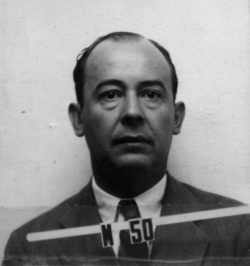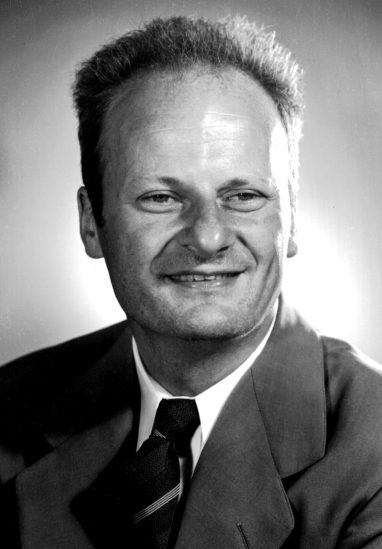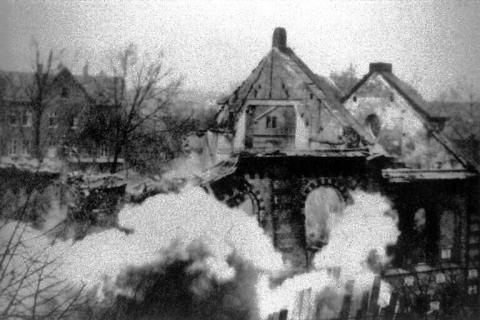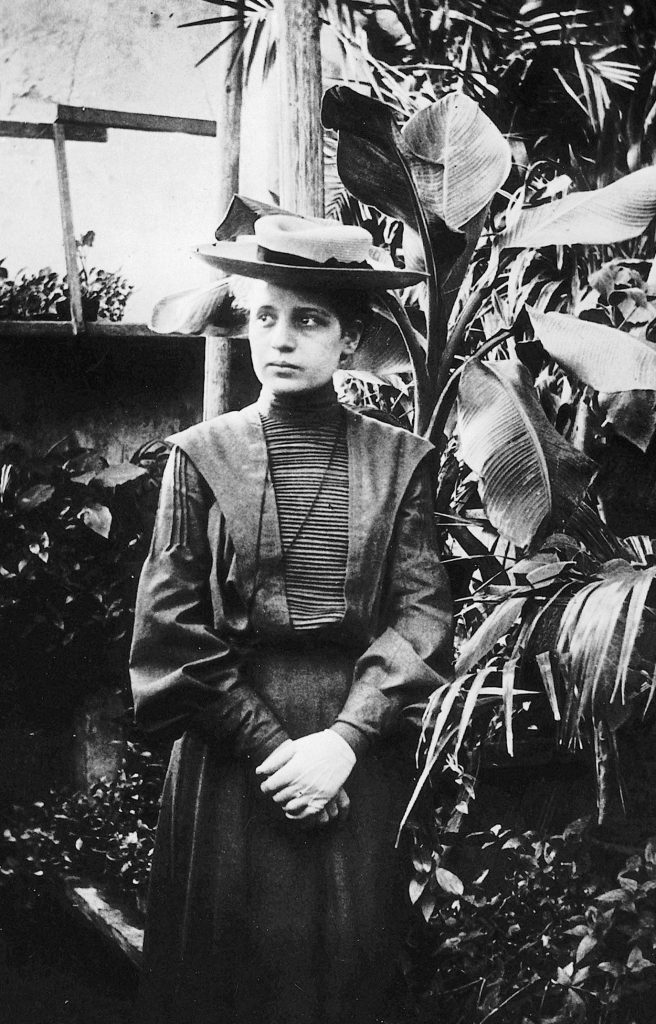One of the ironies of Hitler’s desire for racial purity was that it drove out of continental Europe or into the camps many individuals who would have been extremely useful to the Axis war effort. Nowhere was this more evident than in the effort to produce an atomic bomb. Although many brilliant American physicists worked on the Manhattan Project, including J. Robert Oppenheimer and Richard Feynman, a startling proportion of the most famous names on the project belonged to scientists who came to England or America to flee from the Axis.
The large number of refugees and immigrants working on the Manhattan Project gave the American nuclear program an international character unusual in such a top-secret program—and unique amongst the nuclear programs that followed in other countries—and helped give life in Los Alamos, NM during the war its unique character.
The Shame at Gottingen
As World War I came to a close, there were three main areas where atomic research, in its infancy, was being carried out. At Cambridge University in England, Ernest Rutherford directed the Cavendish Laboratory. In Copenhagen, Danish physcist Niels Bohr carried out a series of pioneering experiments. And at Gottingen University in Germany, research was led by the physicists Max Born and James Franck and the mathematician David Hilbert.
The “Beautiful Years” soon made way to the “Desperate Years” as Adolf Hitler rose to power in Germany. Even before the Nazi takeover, a group of German physicists, as Robert Jungk wrote in his 1958 history Brighter Than A Thousand Suns, “boldly declared Einstein’s theory of relativity to be ‘Jewish world-bluff.’ They attempted to dismiss, under the summary heading of ‘Jewish physics,’ all studies based upon the data of Albert Einstein and Niels Bohr.”
 In the spring of 1933, the University of Gottingen, the seat of brilliant achievement in years past, became the focal point of Hitler’s anti-Jewish policies. Student demonstrations proclaiming the coming of the “new order” became an everyday occurrence. Respected scholars were brutally expelled. Some of the world’s foremost physicists such as Max Born, James Franck, Eugene Wigner, Leo Szilard, Edward Teller, and John von Neumann were forced to flee. Attempts were made by “patriotic German” physicists to prevent the expulsion of so many “brilliant” men, but all to no avail. Even well-known Germans such as Werner Karl Heisenberg and Nobel winners von Laue and Planck were unsuccessful in their attempts at mediation. Many think that Hitler sowed the seeds of Germany’s defeat when he introduced the laws barring Jewish individuals from university teaching posts.
In the spring of 1933, the University of Gottingen, the seat of brilliant achievement in years past, became the focal point of Hitler’s anti-Jewish policies. Student demonstrations proclaiming the coming of the “new order” became an everyday occurrence. Respected scholars were brutally expelled. Some of the world’s foremost physicists such as Max Born, James Franck, Eugene Wigner, Leo Szilard, Edward Teller, and John von Neumann were forced to flee. Attempts were made by “patriotic German” physicists to prevent the expulsion of so many “brilliant” men, but all to no avail. Even well-known Germans such as Werner Karl Heisenberg and Nobel winners von Laue and Planck were unsuccessful in their attempts at mediation. Many think that Hitler sowed the seeds of Germany’s defeat when he introduced the laws barring Jewish individuals from university teaching posts.
Jungk’s book includes the following ancedote:
“The clearest account of the state of the once-great Gottingen University was given by the mathematician David Hilbert, by that time well advanced in years. About a year after the great purge of Gottingen he was seated at a banquet in the place of honor next to Hitler’s new Minister of Education, Rust. Rust was unwary enough to ask: ‘Is it really true, Professor, that your institute suffered so much from the departure of the Jews and their friends?’ Hilbert snapped back, as coolly as ever: ‘Suffered? No, it didn’t suffer, Herr Minister. It just doesn’t exist anymore!’”
Scientists Begin to Flee

In April of 1933, Hitler’s first anti-Jewish law was promulgated, stripping all “non-Aryan” academics of their teaching posts. 25% of German physicists, including eleven past or future Nobel Prize winners, lost their jobs. Emigration was the only solution.
Some with extreme foresight saw what the political landscape was to become and made early plans accordingly. Einstein was one of the first to go. Physicist Theodore von Karman was recruited by the California Institute of Technology in 1930. Caltech, as well as Columbia, pursued Einstein, but he eventually opted for the new Institute for Advanced Study at Princeton. In 1930, Princeton hired both John von Neumann and Eugene Wigner.
_0.jpg) After studying with Werner Heisenberg at Leipzig, Edward Teller briefly remained in Germany, but later told historian Richard Rhodes, “it was a foregone conclusion that I would have to leave. After all, not only was I a Jew, I was not even a German citizen.” Despite his parents’ pleas to return to Hungary, Teller applied for and won a Rockefeller Fellowship to join Bohr in Copenhagen, and left for the United States in 1935.
After studying with Werner Heisenberg at Leipzig, Edward Teller briefly remained in Germany, but later told historian Richard Rhodes, “it was a foregone conclusion that I would have to leave. After all, not only was I a Jew, I was not even a German citizen.” Despite his parents’ pleas to return to Hungary, Teller applied for and won a Rockefeller Fellowship to join Bohr in Copenhagen, and left for the United States in 1935.
After the Rockefeller Foundation rejected his fellowship application, Otto Frisch happened to meet up with Bohr, who was seeking to assist persecuted German scientists. After a short stint with Patrick Maynard Stuart Blackett in London, Frisch also made his way to Copenhagen to work with Bohr.
Nobel laureate James Franck, who also taught at Gottingen, was Jewish but not subject to Nazi racial laws because of his service in World War I. Still, after speaking with Bohr, he resigned his professorship on April 17, 1933.
Joseph Rotblat, a physicist and a Polish Jew, fled Poland before the outbreak of war, but his ill wife was forced to remain behind. She died at the Majdanek concentration camp in the Holocaust. He never remarried. Rotblat later went on to receive the 1995 Nobel Peace Prize for his work on nuclear disarmament.
Always a visionary, Leo Szilard, sacrificing many years of his career and having no permanent post for himself, worked tirelessly to find suitable positions for many of the fleeing scientists. Often working by himself, at the detriment of his own safety and career, Szilard was responsible for numerous colleagues being offered positions. He organized several groups and worked with the Academic Assistance Council, a London-based group headed by Ernest Rutherford that acted as a clearinghouse for information.

At about this same time, groups were forming in America to assist with the “rescue” of noted scientists. At Columbia University, a Faculty Fellowship Fund was established and the U.S. government became involved through its formation of the Emergency Committee in Aid of Displaced German Scholars. According to Frisch, the annual conference Bohr organized in Copenhagen became a “labor exchange.” In September 1933, the Royal Albert Hall in London hosted a benefit for refugee scientists, chaired by Ernest Rutherford and featuring Einstein as the keynote speaker.
In the early years of the exodus, Great Britain took a leading role in finding temporary positions for refugee scientists. After British universities became short of much needed funds, more scientists left for the United States. The Emergency Committee officially welcomed more than 300 scientists and scholars between 1933 and 1941. Of these, approximately 100 were physicists.
First Wave
The first wave of refugees came in 1933, when Adolf Hitler became chancellor of Germany. Many physicists of Jewish descent fled to England to escape racial laws. These included Leo Szilard, who first devised the idea of a nuclear chain reaction; Otto Frisch, who helped explain the physics of nuclear fission; Rudolf Peierls, who worked with Frisch on the detonation mechanism of the bomb; and Hans Bethe, who calculated the critical mass needed for a nuclear chain reaction. Klaus Fuchs, a leftist physicist who later passed atomic secrets to the Soviet Union, also fled to England in 1933 after a violent encounter with the Nazis.
Albert Einstein had left Germany for the United States a year earlier, in anticipation of Hitler’s election. Although Einstein did not contribute directly the bomb effort, his letter to President Roosevelt about the threat of a German atomic bomb helped jump-start the Manhattan Project.
Second wave
Axis expansion brought a second wave of immigrants to the Allies and ultimately to the Manhattan Project. Mussolini’s anti-Semitic laws, passed in 1938, drove the physicists Emilio Segre (a Jew) and Enrico Fermi (whose wife Laura was Jewish) to America. At the Chicago Met Lab, Fermi’s nuclear pile produced the world’s first man-made nuclear chain reaction. Bohr fled his native land in 1943, mere days before he was to be arrested by the Nazis, and served as a consultant on the Manhattan Project.
Peacetime immigrants
In addition to refugees fleeing the Axis, the Manhattan Project also hosted numerous other immigrants, including the Ukranian chemist and explosives expert George Kistiakowsky and the Galician-born physicist Isidor I. Rabi.






